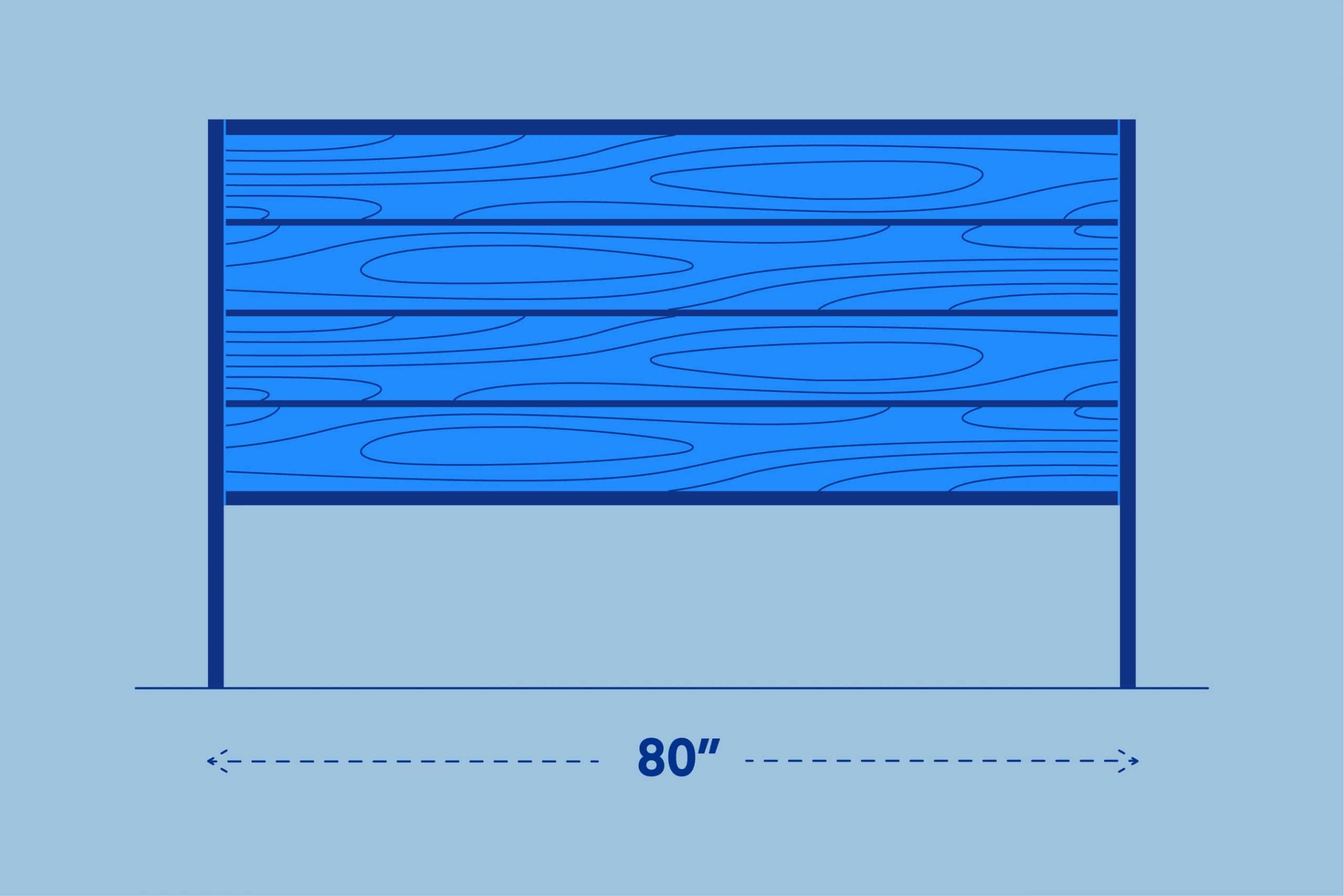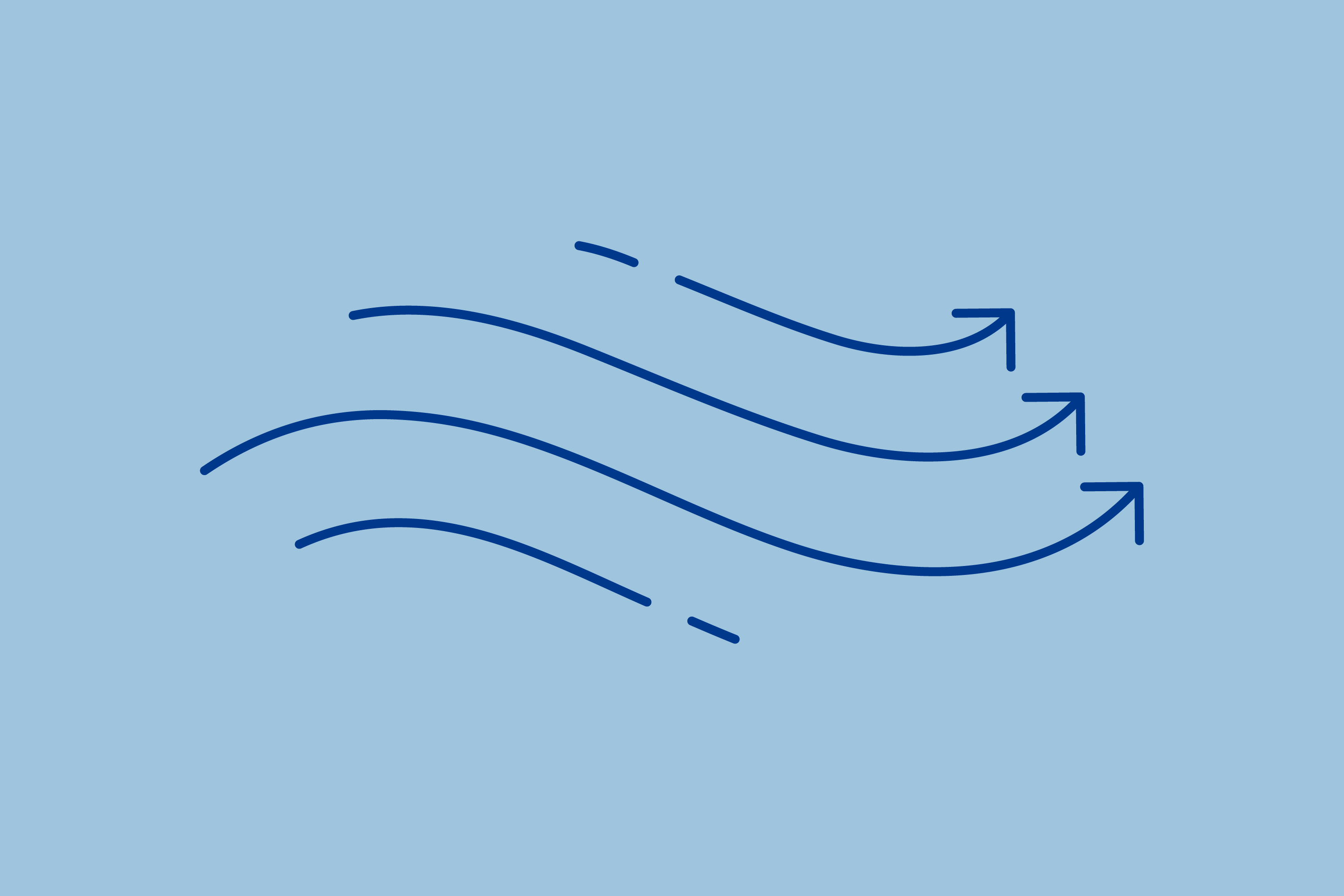Key Takeaways
- Headboard Dimensions: When choosing a headboard, consider its dimensions carefully. Headboards are typically as wide as their compatible mattress sizes, with an additional 2 to 4 inches of width. The height of a headboard can vary, but it should generally be shorter than the length of your bed.
- Types of Headboards: There are various types of headboards available, including wood, metal, upholstered, and storage headboards. Each type has its unique style, materials, and features.
- Attaching a Headboard: Some headboards are meant to be attached to the bed frame, while others are freestanding or wall-mounted. When choosing a headboard, ensure it’s compatible with your bed frame or mattress size, and consider the style that best complements your bedroom decor and needs.
Headboards serve an aesthetic and functional purpose: they provide back support when you are sitting up in bed and they can help complete the look of your bedroom. Headboards are included with some, but not all bed frames. When buying a headboard, consider your mattress size and the available space in your bedroom.
In our guide, we explain how to choose a headboard by looking at headboard dimensions. We’ll also go over the different types of headboards available today.
Headboard Widths
Typically, headboards are as wide as their compatible mattress sizes or around 2 to 4 inches wider. You may need 2 inches of space on either side of the bed to fit a headboard. When buying a new headboard, factor in this extra space so you can buy your other furniture accordingly and avoid overcrowding your room.
Since headboard sizes align with standard mattress sizes, in this table, we provide the approximate headboard widths with their compatible mattress dimensions and the recommended room sizes.
| Bed Size | Headboard Widths | Mattress Dimensions | Recommended Room Size (IN) | Recommended Room Size (CM) |
|---|---|---|---|---|
| Twin | 41 inches | 38 inches by 74 inches | 7 feet by 10 feet | 213.36 cm by 304.8 cm |
| Full | 56 inches | 54 inches by 75 inches | 10 feet by 10 feet | 304.8 cm by 304.8 cm |
| Queen | 62 inches | 60 inches by 80 inches | 10 feet by 10 feet | 304.8 cm by 304.8 cm |
| King | 80 inches | 76 inches by 80 inches | 12 feet by 12 feet | 365.76 cm by 365.76 cm |
| California king | 74 inches | 72 inches by 84 inches | 12 feet by 12 feet | 365.76 cm by 365.76 cm |
A standard queen headboard will suit a queen bed frame in a 10 by 10 foot room, but the same room may look overcrowded if you choose an extra-wide headboard. Extra-wide headboards may be 25 to 30 inches wider than the bed, often extending beyond the bedside tables. The added headboard width makes a bold statement in large rooms, but in small rooms, the extra width clutters the space.
Most extra-wide headboards are wall-mounted, meaning they are attached to the wall and not the bed frame. The bed frames are just placed against the headboard, so you don’t have to worry about size compatibility.
For example, an extra-wide, wall-mounted king size headboard may work with a queen or a California king bed as well as a king size bed. Frame-mounted headboards have to be size compatible because the mounting holes on either side must line up for them to be attached.
Headboard Heights
The effective height of a headboard is what you see above the mattress and not the overall height from the floor. There are no specific standards for headboard heights, though the general rule is to ensure the headboard is shorter than the length of your bed. Most twin, full, queen, king, and Cal king headboards are designed with this in mind.
Generally, twin headboards are 14 inches above the top of the mattress, while full and queen headboards are 28 inches, and king and Cal king headboards are 58 inches.
Tall Headboards
 Tall headboards are commonly used with king or California king mattresses. They look best in rooms with high ceilings because they fill the vertical space, completing the elegance of a king or California king size bed.
Tall headboards are commonly used with king or California king mattresses. They look best in rooms with high ceilings because they fill the vertical space, completing the elegance of a king or California king size bed.
A tall headboard also keeps your head from leaning against the wall when you are using a mattress for sitting up in bed. For this reason, you may want to look at upholstered headboards that offer a little padding for more comfort. Tall headboards may be 65 to 70 inches tall, covering almost the entire length of the wall.
Short or Low Headboards
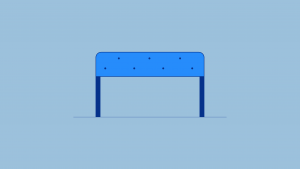 Short or low headboards can make your room look spacious. They are often used with smaller beds in guest rooms. For example, a low headboard for a twin size mattress can be 10 to 12 inches above the top of the mattress.
Short or low headboards can make your room look spacious. They are often used with smaller beds in guest rooms. For example, a low headboard for a twin size mattress can be 10 to 12 inches above the top of the mattress.
They are a perfect option when you want to hang a painting, photo, or wall decor above your bed. Their compact size can also make a small bedroom look bigger.
Adjustable Headboards
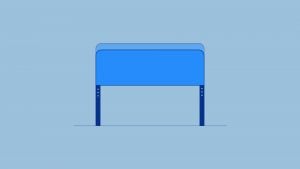 Adjustable headboards usually include metallic legs that can be moved up or down to adjust the height. An adjustable headboard is an excellent option when you are unsure which headboard height is most suitable for your room.
Adjustable headboards usually include metallic legs that can be moved up or down to adjust the height. An adjustable headboard is an excellent option when you are unsure which headboard height is most suitable for your room.
If you have a big bed in a small room, adjust the headboard height to a shorter level so the room appears spacious. Adjustable headboards also come in handy if you change your mattress to a thicker or thinner one. That way, you don’t have to buy a new headboard to fit your new mattress.
Different Types of Headboards
The thickness of your headboard depends on the type. Fancy headboards with shelves and drawers are thicker than the plain wooden or metal headboards. These simple headboards may be 2 to 3 inches thick, while headboards with built-in storage can be 7 to 10 inches thick.
When it comes to headboard type, you’ll also have to think about the materials and if they mesh with your other bedroom decor. Platform beds or panel beds both mesh well with different types of headboards, depending on whether they have a classic or modern look.
Wood Headboard
 Wood is one of the most popular furniture building materials. People prefer wooden headboards because they suit both classic and contemporary decor. Wooden headboards can be made up of one solid wooden panel, 3 to 4 panels joined together, or plain wooden spindles.
Wood is one of the most popular furniture building materials. People prefer wooden headboards because they suit both classic and contemporary decor. Wooden headboards can be made up of one solid wooden panel, 3 to 4 panels joined together, or plain wooden spindles.
Pine, oak, and maple are some of the common types of wood used to make headboards. Plywood is a comparatively budget-friendly option, but it’s not as durable as pine, oak, or maple.
Wooden headboards flaunt a natural wood finish, or they are painted in earthen shades like brown, black, or grey.
Wood headboards are common with platform, sleigh, four-poster, and bunk beds as well. Families with more than one child prefer bunk beds because they optimize space, increasing play areas for children.
Four-poster and sleigh beds are often found in queen or king sizes because these regal styles are suitable for large rooms. The outward curve of the headboard in a sleigh needs more space, while the posters on all four corners of a bed can crowd your room. Platform beds don’t take up as much space and are suitable for all room sizes.
Metal Headboard
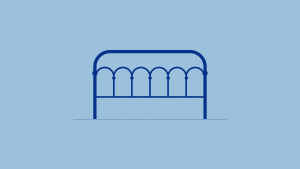 Metal headboards can offer a modern, industrial, minimalist, or a vintage look, depending on their design. They are an affordable option compared to pine, oak, or maple wood. Metal headboards can be made of wrought iron, brass, brushed aluminum, or stainless steel. They are found in various colors such as silver, nickel, gold, black, brown, and white.
Metal headboards can offer a modern, industrial, minimalist, or a vintage look, depending on their design. They are an affordable option compared to pine, oak, or maple wood. Metal headboards can be made of wrought iron, brass, brushed aluminum, or stainless steel. They are found in various colors such as silver, nickel, gold, black, brown, and white.
Metal headboards are common with platform and bunk beds, in all standard sizes. Sometimes, they are also used with four-poster bed frames.
Upholstered Headboard
 Upholstered headboards are the most comfortable because the soft padding provides a plush backrest when you are sitting up in bed, negating the need for a reading or backrest pillow.
Upholstered headboards are the most comfortable because the soft padding provides a plush backrest when you are sitting up in bed, negating the need for a reading or backrest pillow.
They are also a good option for active sleepers, protecting them from getting hurt even if they bump their head on the headboard.
The padding in upholstered headboards can include cotton, linen, leather, or polyester. The price of the headboard depends on the quality of materials used in the padding. They are available in a wide variety of colors, making them popular even in kids’ bedrooms.
An upholstered headboard may be solid-colored, printed, or tufted. Upholstered headboards can be used with any type of bed frame, and are usually thicker than simple wood or metal headboards.
Storage Headboard
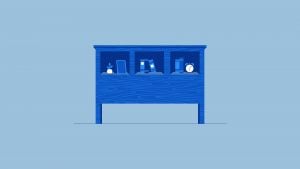 Storage headboards are usually made of wood, providing you enough space to keep your books, alarm clock, or other bedroom essentials in them. They are commonly used with platform and bunk beds.
Storage headboards are usually made of wood, providing you enough space to keep your books, alarm clock, or other bedroom essentials in them. They are commonly used with platform and bunk beds.
Storage headboards are the thickest of all types, so you need a large bedroom to accommodate them. If you don’t have room for one but still want a nice way to store things near the bed, you might want to go with a classic nightstand or look at some underbed storage options. A set of rattan drawers with bed risers can be a classy way to store some items.
Why Use a Headboard?
Headboards can add a sense of style and sophistication to your bedroom. With a wide variety of materials, colors, and designs available, headboards can complement your personal style and add a focal point to your bedroom decor. You can style a king bed with one, but they work well with smaller bed sizes too.
However, the purpose of a headboard goes beyond just being a decorative element in a bedroom. It can serve several functional purposes that can enhance the comfort and overall look of your bed.
Firstly, headboards can provide additional support and comfort for your back and neck while sitting up in bed. With a headboard, you can lean back against it comfortably while sitting up on a mattress and reading or watching TV.
Similarly, headboards can help prevent your pillows from slipping off the bed during the night. This can be especially useful if you are a combination sleeper and tend to move around a lot in your sleep.
Originally, headboards were also a way to keep sleepers insulated. While this is less necessary in modern homes, it’s still something to keep in mind as you set up the bedroom to promote the best temperature for sleep.
Headboards can also still serve an important function as a barrier between your bed and the wall, protecting your bedding and walls from wear and tear. This can be especially useful if you have a tendency to move around a lot in your sleep or have a tendency to sit up in bed.
Do I Need to Attach a Headboard to a Frame?
Not necessarily, though many headboards are meant to be secured to a bed frame using bolts or screws. These headboards are a sturdy and secure option that can add a classic, timeless look to your bedroom. However, there are also freestanding and wall-mounted headboards, neither of which are bolted to the bed frame.
Freestanding headboards are standalone units that are placed behind the bed and do not require any attachment to the bed frame or the wall. They are a great option for those who want flexibility in their bedroom design or who frequently move their furniture around. Freestanding headboards can also be used with any bed frame or mattress size, making them a versatile choice.
Wall-mounted headboards, as the name suggests, are attached directly to the wall and do not require any connection to the bed frame. They can be a great space-saving option for smaller bedrooms and can also add a stylish, modern look to your space. However, it’s important to keep in mind that wall-mounted headboards may require professional installation and may not be as versatile in terms of bed frame or mattress size compatibility.
When choosing a traditional headboard that you attach to your frame, remember to check if it’s compatible with your specific bed frame and mattress size before purchasing. If you have an odd sized antique frame or a similarly unique bed, you may want to avoid the hassle of a custom size and choose a freestanding or wall-mounted headboard.
A common budget bedroom makeover hack is to also just paint the appearance of a headboard on a wall. For some sleepers, this lets them express their creativity while also saving on the expense of a headboard and the hassle of installing one.
Choosing the Right Headboard Size for Your Bedroom
When it comes to choosing the right headboard size for your bed, whether’s completing a twin bed or an Eastern king bed, it’s important to measure your bedframe properly to ensure a proper fit. Here are some simple steps you can follow to measure your bedframe and determine the perfect headboard size for your needs:
- First, use a measuring tape to measure the width of your bedframe from one end to the other. Be sure to measure the widest point of the frame, which may be at the top or bottom.
- Then, use your measuring tape to measure the height of your bedframe from the floor to the top of the frame. Make sure to measure at the highest point of the frame, which may be at the head or foot of the bed. If you use bed risers or other bed frame extensions, you should account for their added height, too.
- Consider also how much depth of headboard your bedroom can accommodate. For example, do you only have space for one or two inches, or can you pull your frame forward to fit in the deeper shelves of a storage headboard?
- Once you have your measurements, you can choose the right headboard size to fit your bed frame. Remember to factor in any decorative elements or panels on your bedframe that may extend beyond the mattress. Whether or not your bedframe is streamlined may impact the size and style of headboard that will work best for your bed.
Of course, while taking your frame’s measurements can help you choose the right size of headboard, you’ll need to look not just at your existing bed frame but overall bedroom setup to choose the right style of headboard.
For example, if you have a number of books or a plant in your bedroom, you may want the functionality of a storage headboard. If you’re focused on minimalism in your bedroom, you may prefer a simple metal or wooden headboard.
Even how you arrange your pillows can affect what the best headboard for your needs is. We have a number of bedroom guides that can help you think about what headboard style will best slide into your room’s existing decor:
- Creating a Calm, Clutter-Free Bedroom
- Best and Worst Bedroom Colors for Sleep
- Tips for a Healthy Bedroom
- How To Create The Perfect Sleep Environment
Don’t hesitate to consult with a decorating professional or refer to manufacturer guidelines if you have any questions or concerns about selecting the right headboard size for your bed.
More Mattress and Bedding Size Guides
- RV Mattress Sizes and Types
- Mattress Sizes and Dimensions in Canada
- Bunk Bed Mattress Size Guide
- Hospital Bed Mattress Sizes and Dimensions
- Bed Sheet Sizes and Dimensions Guide
- Bed Frame Sizes and Dimensions Guide
- Mattress Protector Sizes and Dimensions Guide
- Adjustable Bed Sizes and Dimensions Guide
- Blanket Sizes and Dimensions Guide
- Murphy Bed Sizes and Dimensions Guide
- Bed Pillow Sizes Guide
- Pillowcase Sizes and Dimensions
- Mattress Foundation Sizes and Dimensions Guide
- Duvet Sizes and Dimensions Guide
- Comforter Sizes and Bedding Chart
FAQs
What size should a headboard be?
The headboard size should be compatible with your mattress size for the perfect fit. Most twin, full, queen, king, and Cal king headboards are as wide as their compatible mattresses or 2 to 4 inches wider. The standard height varies between 14 to 58 inches, depending on the size of the bed.
For example, a twin size headboard dimensions can be 41 inches wide and 14 inches tall, while a king size headboard dimensions can be 80 inches wide and 58 inches tall. A headboard can be 2 to 10 inches thick, depending on its design.
What are the dimensions of a queen size headboard?
Queen headboards range from 60 to 64 inches wide by 28 to 48 inches tall. The thickness depends on your preference for the type of headboard. Simple headboards are 2 to 4 inches thick, while headboards with storage are 7 to 10 inches thick. Choose one depending on the space in your room and your stylistic preferences.
What is the best height for a headboard?
There is no best height for a headboard, but the general rule is to keep them shorter than the length of the bed.
Taller headboards often look good in large rooms with raised ceilings or higher mattress thickness, while shorter headboards can make a small room look more spacious. Generally, the standard height of a twin headboard is 14 inches, full and the queen is 28 inches, and a king is 58 inches.
Can a full size headboard fit a queen?
A full mattress is 6 inches narrower than a queen mattress so a full size headboard will not fit a queen size bed frame. The mounting holes on a full headboard will not line up with those on the queen bed frame, which is necessary to join them together. Typically full headboards are 56 inches, while queen headboards are 62 inches wide.
How do you fix a gap between a mattress and a headboard?
To fix the gap between a mattress and a headboard, use an upholstered headboard, as the thick padding helps to cover the gap. If the gap is more than 1.5 inches, use mattress wedges as a filler. These triangular foam products extend along the entire width of the mattress, filling the gap between the bed and the headboard. You will find mattress wedges in most home improvement and online stores.
Conclusion
Headboards were originally designed to serve as an added layer of insulation; they protected sleepers from feeling cold when the bed was placed against the wall which radiated the chill of the outside environment. In modern-day homes, these headboards serve more of an aesthetic purpose. They can redefine the look of your bedroom, making it classy, elegant, vintage, or contemporary.
As a reminder, their dimensions may vary widely. A queen size headboard dimensions may be 62 inches and roughly just as tall, or it can be far shorter. It may jut out 2 inches or it may be about a foot thick with shelves. You’ll want to measure your mattress and bed frame when considering if a particular headboard is right for you.
If you want to revamp your bedroom, consider changing the headboard for a brand new look. Headboards can serve a functional purpose as well, like protecting you from bumping your head or providing extra storage space.
About the author
Geoff McKinnen is a writer focusing mainly on the healthcare industry and has written articles on everything from foods to help you lose weight to the connection between Alzheimer’s and sleep. Geoff’s passionate about helping readers improve their well-being to lead happier lives. Outside of work, Geoff enjoys cycling and hiking and believes that by leading a healthy lifestyle, he can help others do the same.
View all posts